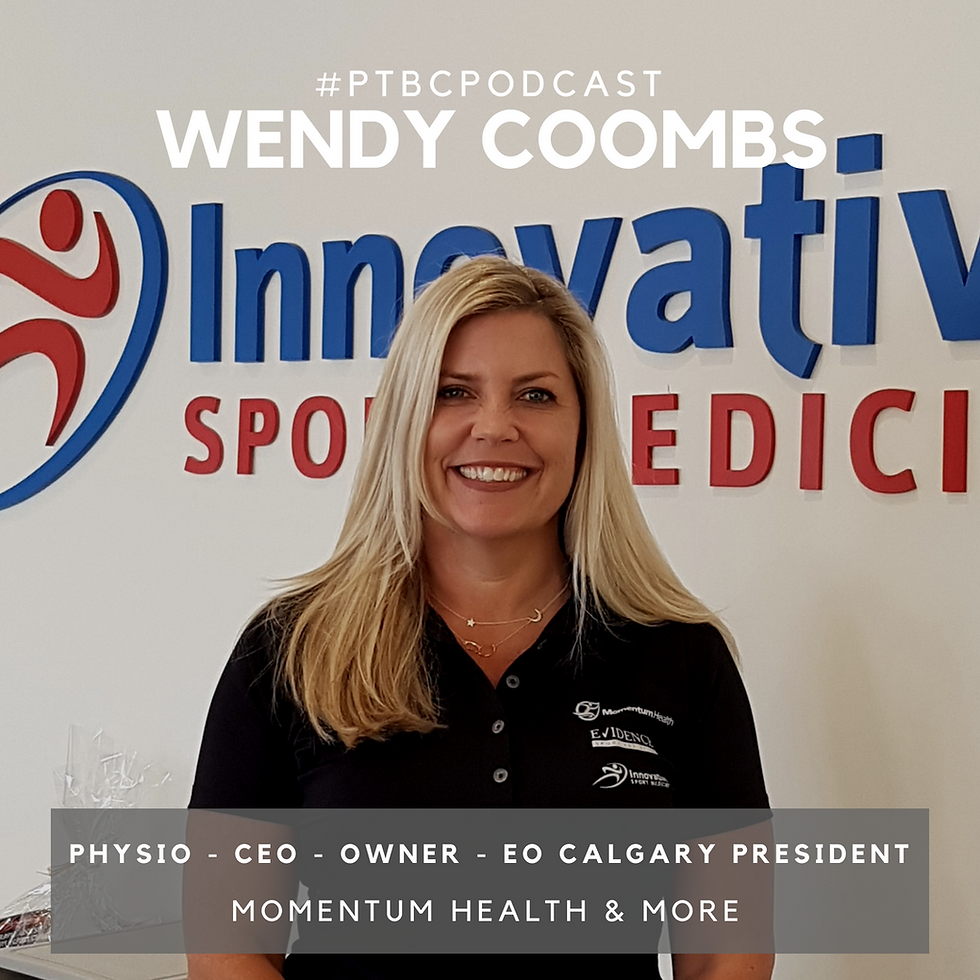Lessons Learned with Wendy Coombs
- PT Business Corner

- Aug 17, 2018
- 4 min read
Welcome to the newest “Lessons Learned” with Wendy Coombs, owner of Momentum Health, Evidence Sport and Spine and Innovative Sport Medicine, a chain of 12 multidisciplinary clinics in Calgary, Alberta. Wendy is the current president of the Calgary Entrepreneurs Organization. She holds two Bachelor of Science degrees in Psychology and Physical Therapy from the University of Alberta. Wendy has also grown fourteen separate businesses from a single physiotherapy clinic into medical centers offering physiotherapy, massage therapy, sport and spinal medicine and chiropractic services. We were grateful to have the opportunity to chat with Wendy and discuss partnerships and entrepreneurial excellence.
With many years of experience working with healthcare and business, Wendy had plenty of information about her journey and shared some valuable lessons with us. You can listen to the full entertaining podcast HERE while we provide you with a summary of the top 5 lessons.
Lesson 1: Structuring Business Partnership Agreements
Wendy has a business partner involved in each of her current 12 clinics. In addition, each clinic has minority partners that are shareholders as well. Wendy emphasizes that it is important to develop an identity and a role for each of the partners. For example, her minority partners are all clinicians, responsible for generating revenue. Each minority partner is also a clinic director, in charge of running the day to day operations in the clinic. Finally, the minority partner is also a shareholder, which means that each of Wendy's partners has 3 revenue streams. Wendy highlights that it is important to leave clinic owners in charge of making decisions as they are able to make the best judgement calls for the patients and staff in the clinic. Ultimately, by providing each of her partners with a clear and defined role, the risk of miscommunication is reduced.
Lesson 2: Clinic Adaptability
When a large chain of clinics acquires a smaller standalone clinic, they often allow the owner to retain a minority equity. However, the decision making tends to become a top-down business partnership model. This is important in order to roll out the same systems and processes across a large number of clinics, but according to Wendy, the model is somewhat limited. In particular it prevents an individual clinic from being adaptable. For each clinic, there are different patient demographics, staffing requirements and even economical differences. Hence, while a particular model may work great in Ontario, applying the same systems in another province may not work as well. Therefore, while the chain of clinics may have excellent systems in place and uniform continuity throughout the branches, a potential issue with this model may be the lack of adaptability of each individual clinic.
Lesson 3: How to Profit
According to Wendy, if profit is your number one priority, then it seldom comes as expected. In order to create a profitable clinic, your goal should be to provide an exceptional patient experience for each and every patient. Wendy highlights that it is important to focus on developing strong clinical outcomes in order to develop profitability. Finally, happy staff is another key ingredient to profiting. Wendy notes that if your staff enjoys coming to work and has a strong passion for their job, then you are more likely to see profit. By focusing on these three areas, you will greatly increase the likelihood of profitability for your physiotherapy clinic.
Lesson 4: Solo Business Structures
Wendy states that sole proprietorships are the most common business structure across all industries and prominent in the physiotherapy community as well. Essentially, it means that there is one individual, or a married couple in business alone and in charge of operating the business. Wendy mentions that there are many advantages to having a sole proprietorship, including the fact that it is a simple business model to form and overall, there are fewer taxes and legal controls than with a much larger business. In addition, Wendy highlights that by opening up a physiotherapy clinic as a sole proprietor, you are able to enjoy the flexibility and autonomy of growing your own business. However, some of the challenges are that you aren’t able to have the same scalability that larger businesses can afford. For example, it’s much tougher to take time off or replace yourself when you are running a clinic alone, versus the ease of having a partner handle your workload as you go on vacation. Also, you are personally liable for all of the business debt as a sole proprietor and hence there is increased risk, as compared to being incorporated.
Lesson 5: The Role of a Partner
Wendy finds that individuals often tend to bring on partners, but their justification is often lacking. For example, some clinic owners mention that they need money to operate their clinic so they bring on a silent partner for some financial assistance. Wendy counters by noting that it is better to ask the bank or friends and family, instead of giving away equity just to get funding for your startup business. However, Wendy notes that if your partner provides financial aid and but is also responsible for operating the business, then it’s a great idea to bring them on. Some clinic owners find a partner so that they can expand into bigger clinics, which Wendy says is a fantastic idea, as these owners are essentially taking a smaller piece of a bigger pie. In addition, sharing the workload of an expanding business is beneficial for the work-life balance of clinic owners. Ultimately, as a clinic owner it is important to carefully analyze the reasons for bringing on a potential co-owner to ensure the success and profitability of your clinic.
These were a glimpse of some of the great lessons that we took away from Wendy! For a full interview, you can access HERE.




Comments